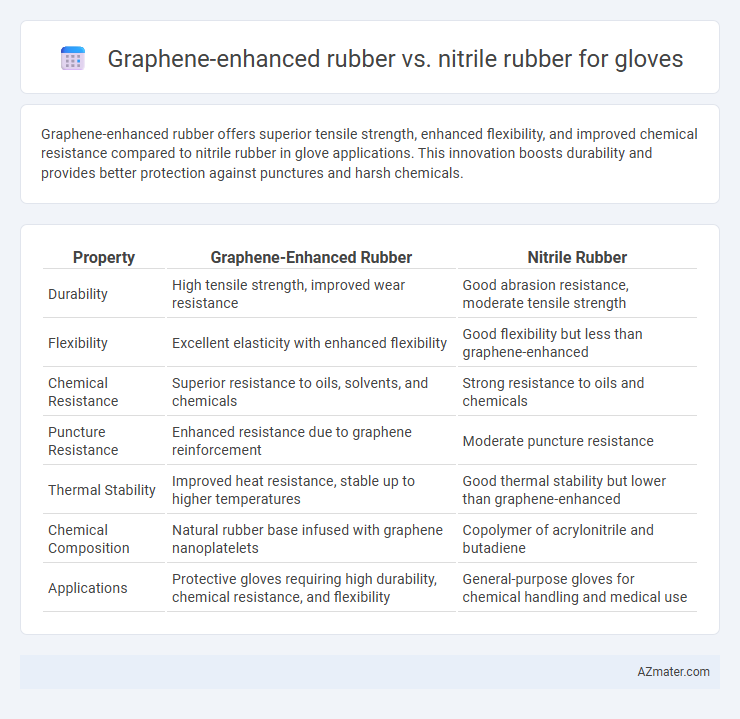Graphene-enhanced rubber offers superior tensile strength, enhanced flexibility, and improved chemical resistance compared to nitrile rubber in glove applications. This innovation boosts durability and provides better protection against punctures and harsh chemicals.
Table of Comparison
| Property | Graphene-Enhanced Rubber | Nitrile Rubber |
|---|---|---|
| Durability | High tensile strength, improved wear resistance | Good abrasion resistance, moderate tensile strength |
| Flexibility | Excellent elasticity with enhanced flexibility | Good flexibility but less than graphene-enhanced |
| Chemical Resistance | Superior resistance to oils, solvents, and chemicals | Strong resistance to oils and chemicals |
| Puncture Resistance | Enhanced resistance due to graphene reinforcement | Moderate puncture resistance |
| Thermal Stability | Improved heat resistance, stable up to higher temperatures | Good thermal stability but lower than graphene-enhanced |
| Chemical Composition | Natural rubber base infused with graphene nanoplatelets | Copolymer of acrylonitrile and butadiene |
| Applications | Protective gloves requiring high durability, chemical resistance, and flexibility | General-purpose gloves for chemical handling and medical use |
Introduction to Glove Materials: Graphene-Enhanced Rubber vs Nitrile
Graphene-enhanced rubber exhibits superior tensile strength, flexibility, and electrical conductivity compared to traditional nitrile rubber, making it a cutting-edge material for protective gloves. Nitrile rubber is widely used due to its excellent chemical resistance and puncture durability, particularly in medical and industrial applications. The integration of graphene into rubber matrices significantly improves mechanical properties and barrier performance, offering enhanced protection and longevity over standard nitrile gloves.
Material Composition and Structure
Graphene-enhanced rubber incorporates nanoscale graphene sheets within a traditional rubber matrix, significantly improving tensile strength, elasticity, and puncture resistance due to graphene's exceptional mechanical properties and high surface area. Nitrile rubber, a synthetic copolymer of acrylonitrile and butadiene, features a molecular structure optimized for chemical resistance and durability, making it widely used in gloves for protection against oils and solvents. The integration of graphene into rubber composites modifies the microstructure by establishing strong interfacial bonding and enhancing electron mobility, resulting in gloves with superior performance characteristics compared to standard nitrile rubber.
Mechanical Strength and Durability
Graphene-enhanced rubber significantly outperforms nitrile rubber in mechanical strength due to graphene's exceptional tensile properties, resulting in gloves that resist punctures and tears more effectively. The incorporation of graphene also enhances durability by improving resistance to wear and degradation under harsh conditions, extending the glove's operational lifespan. In contrast, while nitrile rubber offers good chemical resistance and moderate strength, it lacks the superior reinforcement and longevity benefits provided by graphene composites.
Chemical and Puncture Resistance
Graphene-enhanced rubber gloves exhibit superior chemical resistance due to graphene's exceptional barrier properties, effectively reducing permeation of solvents and oils compared to traditional nitrile rubber gloves. The integration of graphene significantly increases puncture resistance, enhancing durability and protection against sharp objects in industrial and medical environments. Nitrile rubber, while widely used for chemical resistance, generally offers lower mechanical strength and puncture resistance than graphene-enhanced composites.
Comfort, Fit, and Tactile Sensitivity
Graphene-enhanced rubber gloves offer superior flexibility and elasticity compared to nitrile rubber, resulting in enhanced comfort and a more precise fit. The exceptional strength and thinness of graphene layers allow for heightened tactile sensitivity, making tasks requiring fine motor skills easier to perform. Nitrile gloves, while durable and resistant to chemicals, often lack the same level of softness and responsiveness, which can impact overall comfort and dexterity during extended wear.
Barrier Protection Against Pathogens
Graphene-enhanced rubber gloves offer superior barrier protection against pathogens compared to traditional nitrile rubber gloves, due to graphene's exceptional antimicrobial properties and higher durability. The integration of graphene significantly improves resistance to punctures, tears, and chemical penetrants, ensuring enhanced safety in medical and industrial environments. Nitrile gloves, while effective, lack the advanced molecular structure of graphene, resulting in comparatively lower pathogen impermeability.
Breathability and Moisture Control
Graphene-enhanced rubber gloves exhibit superior breathability due to graphene's exceptional thermal conductivity, allowing better heat dissipation and reduced hand sweating compared to nitrile rubber gloves. This enhanced breathability directly improves moisture control by preventing the accumulation of sweat, promoting greater comfort during extended wear. Nitrile rubber, while resistant to oils and chemicals, typically lacks the advanced moisture-wicking properties provided by graphene integration, making graphene-enhanced gloves a preferable choice for users prioritizing sweat management and comfort.
Environmental Impact and Sustainability
Graphene-enhanced rubber outperforms nitrile rubber in environmental impact by offering increased durability and reduced raw material consumption, leading to lower waste generation and extended glove lifespan. The incorporation of graphene reduces the need for frequent glove replacements, minimizing resource depletion and landfill accumulation. Nitrile rubber, while widely used for gloves, typically requires more frequent disposal and involves higher energy-intensive production processes, making graphene-enhanced alternatives a more sustainable choice.
Cost Efficiency and Market Availability
Graphene-enhanced rubber offers superior durability and chemical resistance compared to traditional nitrile rubber, potentially extending glove lifespan and reducing replacement frequency. However, the higher production costs of graphene composites currently limit their widespread market availability and increase upfront expenses. Nitrile rubber gloves remain more cost-efficient and readily accessible, dominating the market due to established manufacturing infrastructure and competitive pricing.
Future Trends and Innovations in Glove Manufacturing
Graphene-enhanced rubber offers superior tensile strength, flexibility, and puncture resistance compared to traditional nitrile rubber, driving innovation in glove manufacturing towards more durable and high-performance protective gear. Emerging trends highlight the integration of nanomaterials like graphene to enhance chemical resistance and thermal conductivity, expanding glove applications in medical, industrial, and hazardous environments. Future developments focus on sustainable production methods and customizable glove properties through advanced graphene composites, promising significant improvements in safety and user comfort.

Infographic: Graphene-enhanced rubber vs Nitrile rubber for Glove
 azmater.com
azmater.com